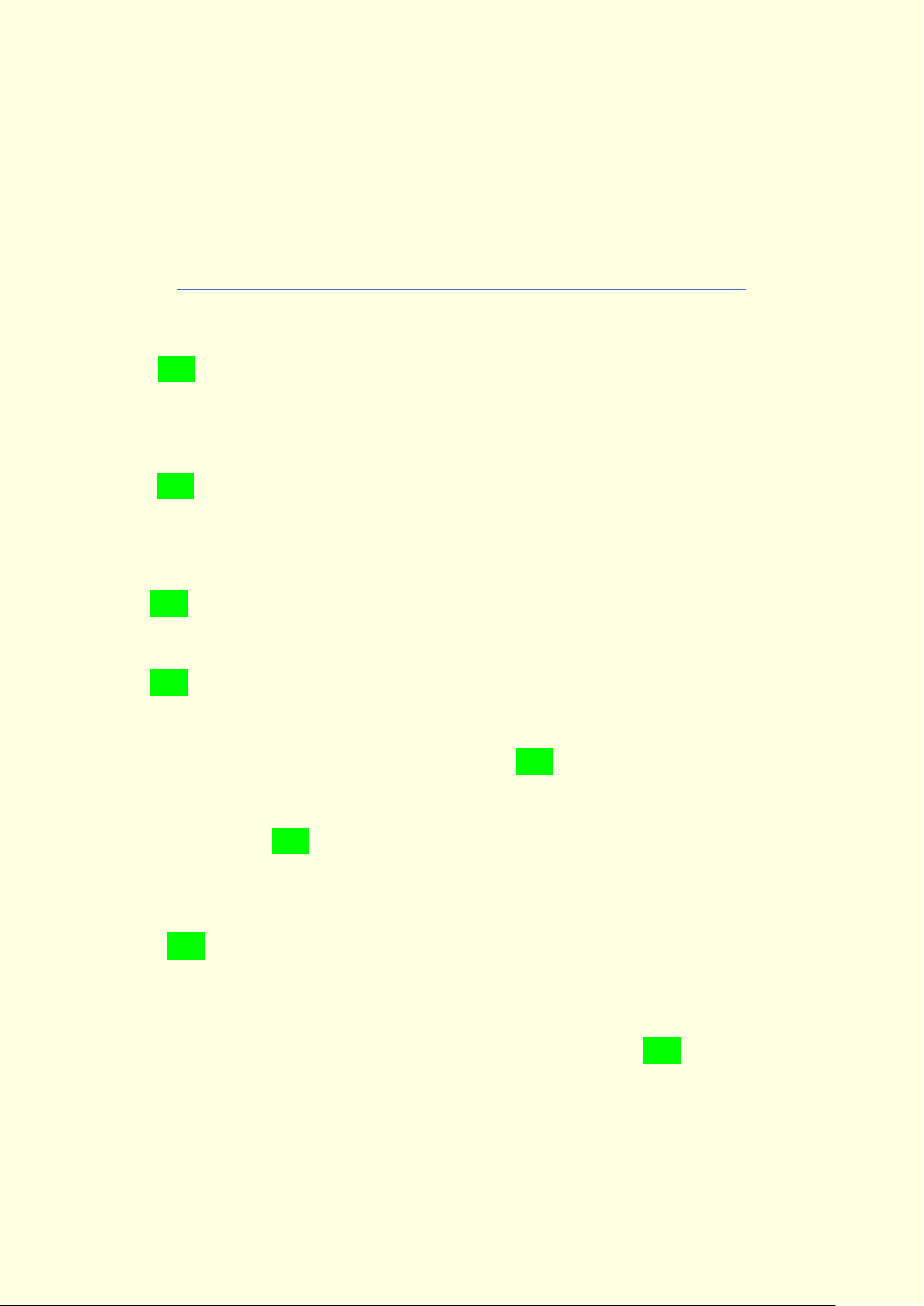
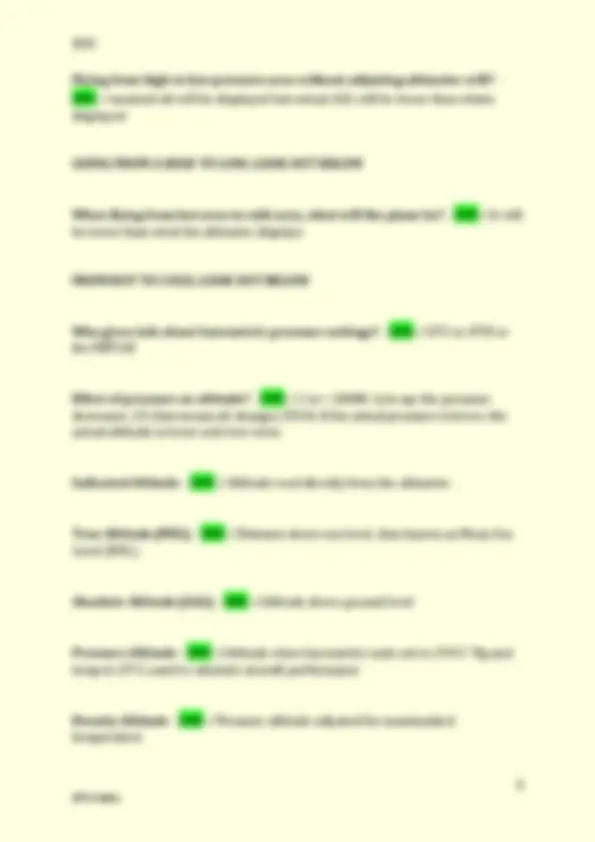
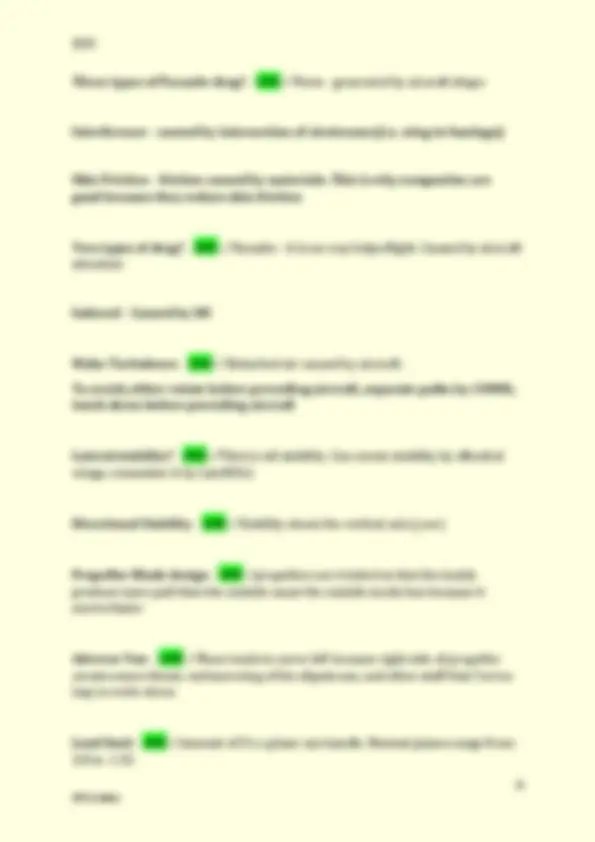
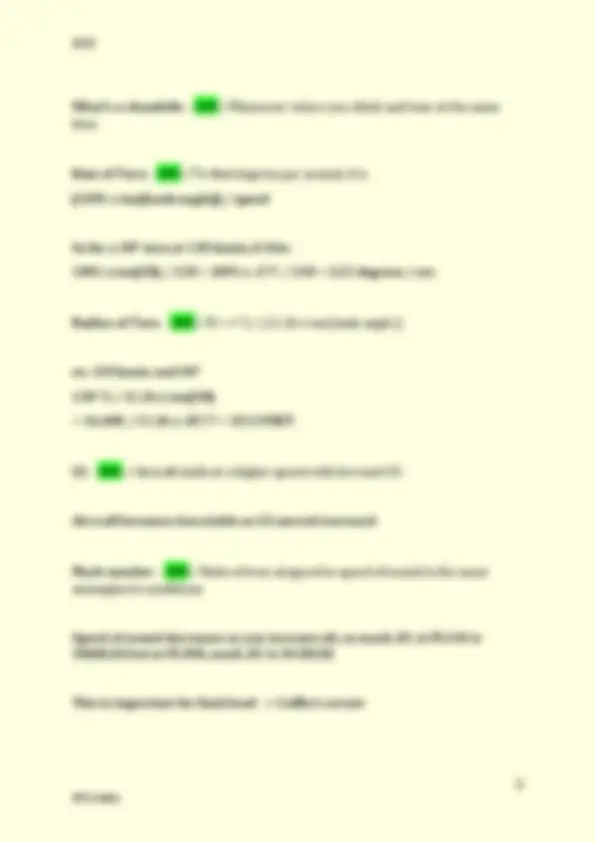
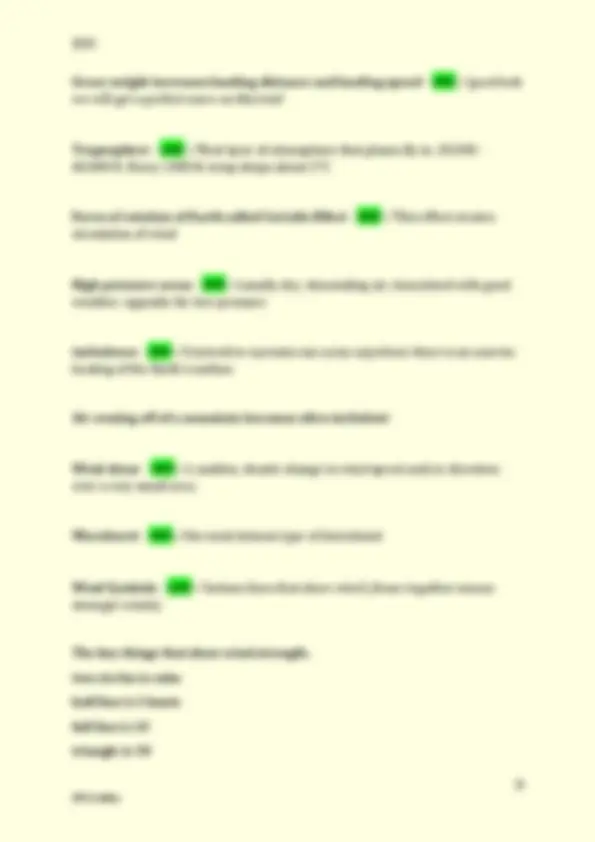
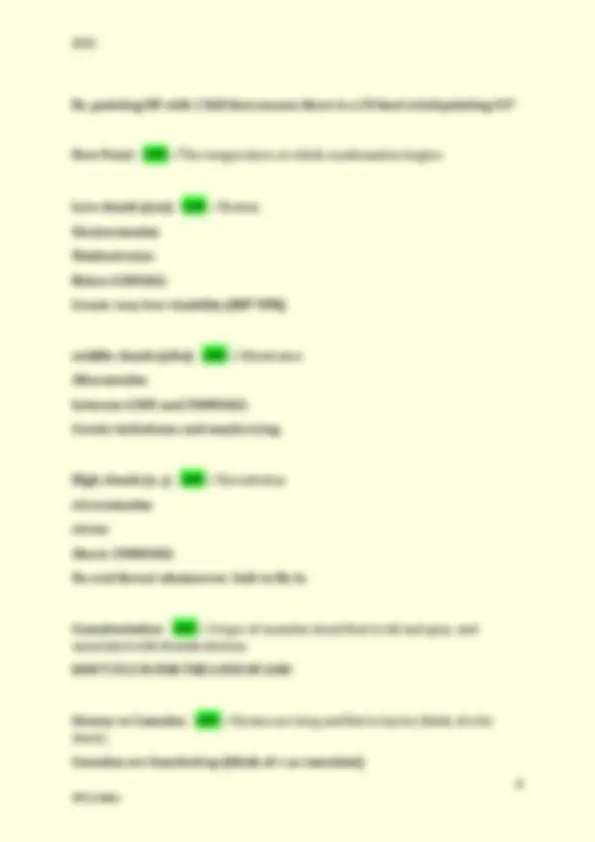
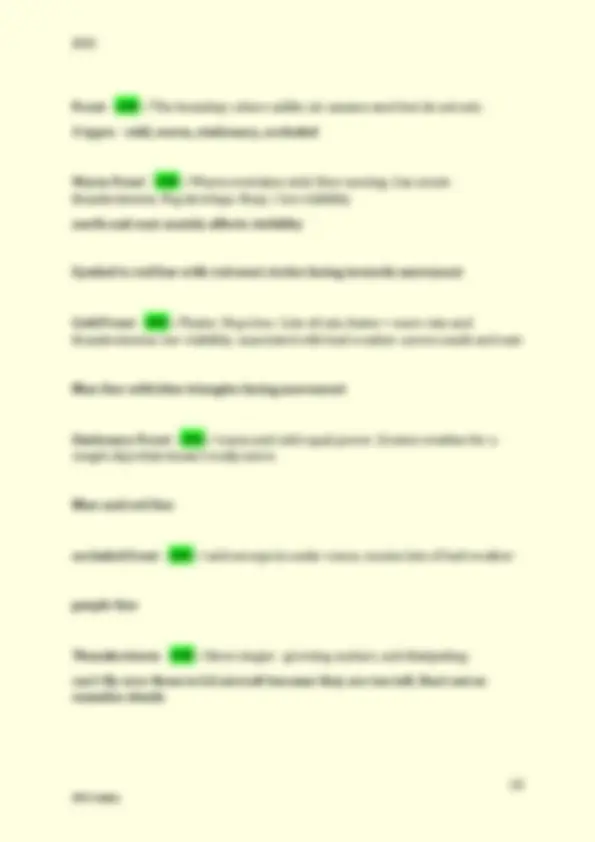

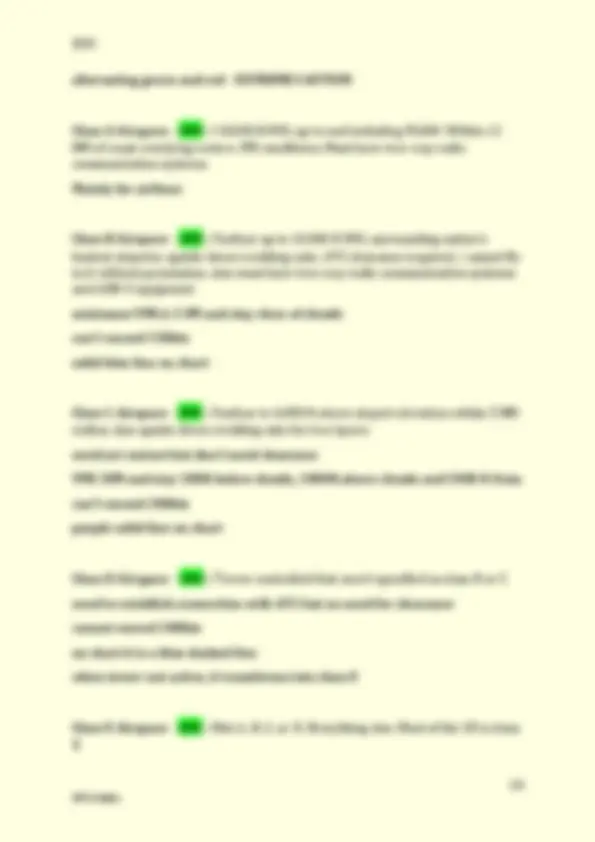
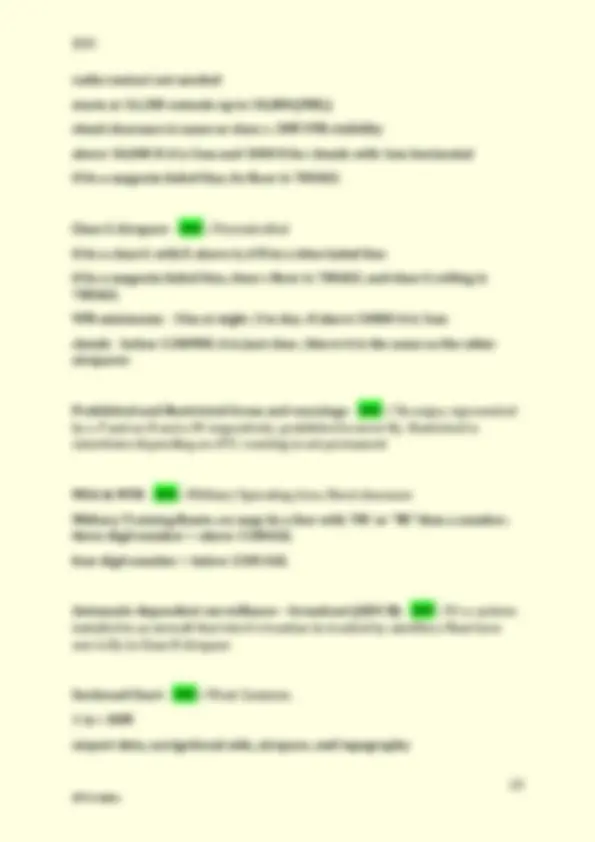
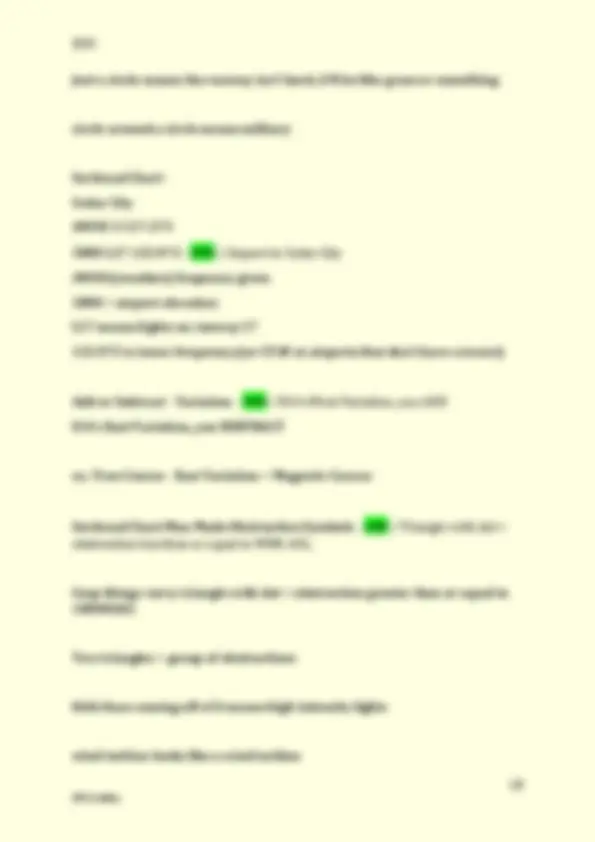
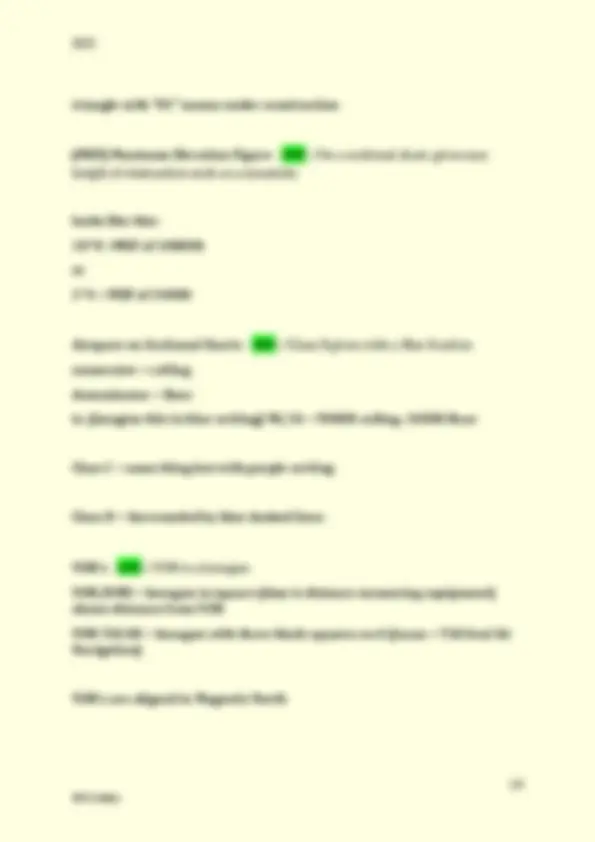
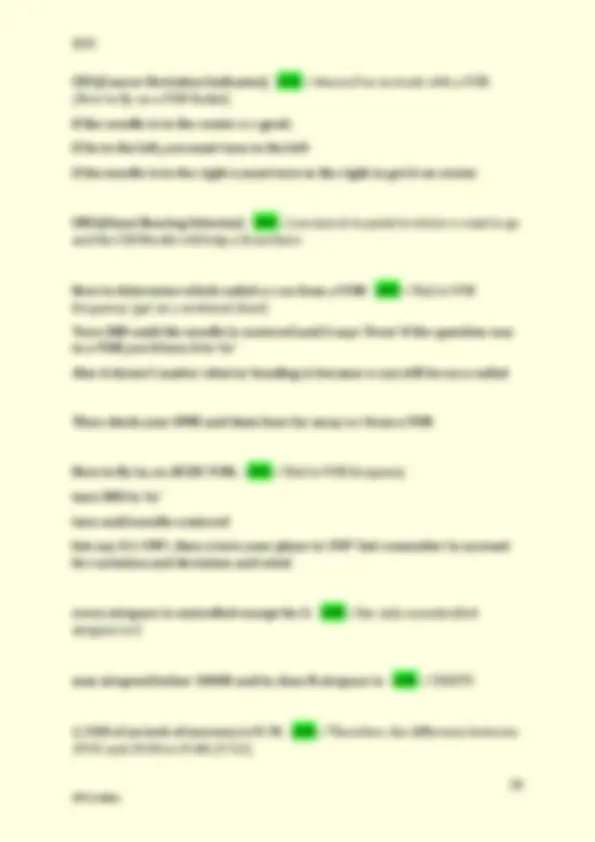
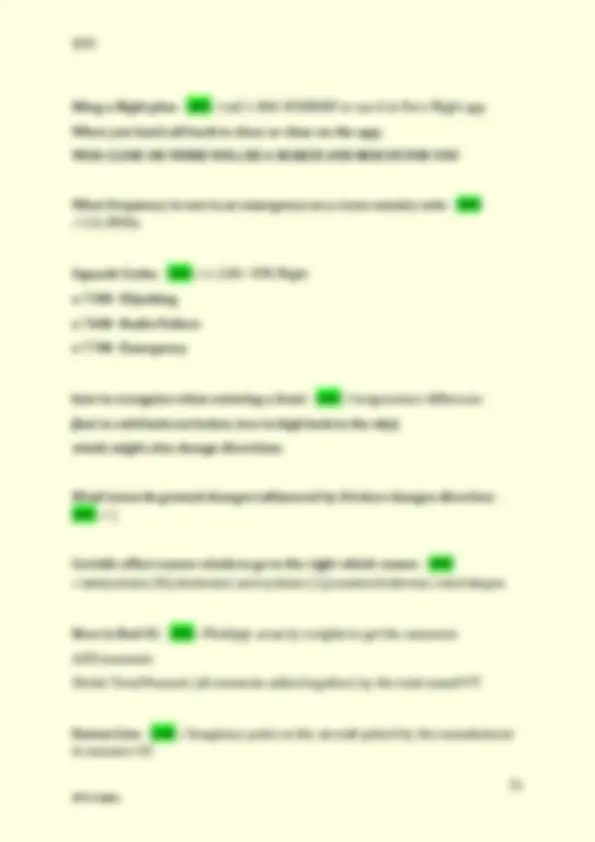
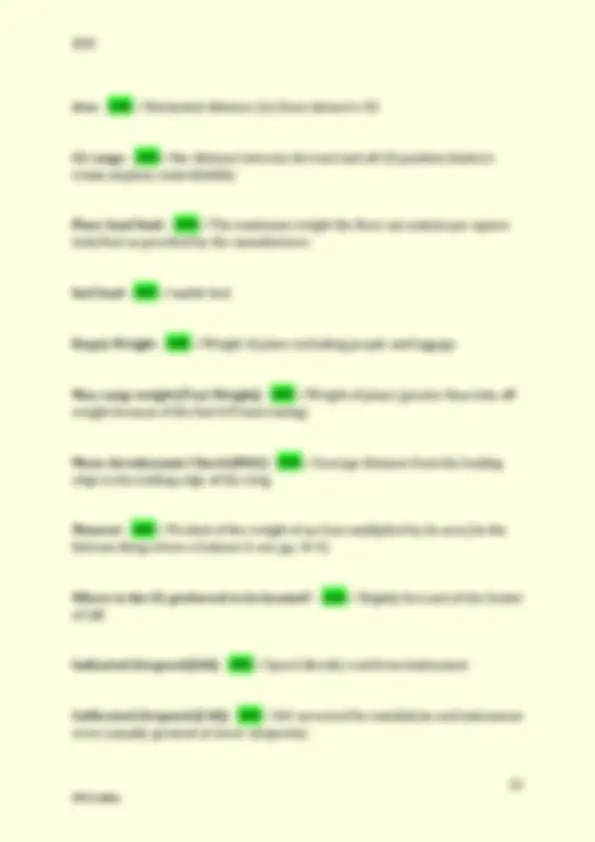
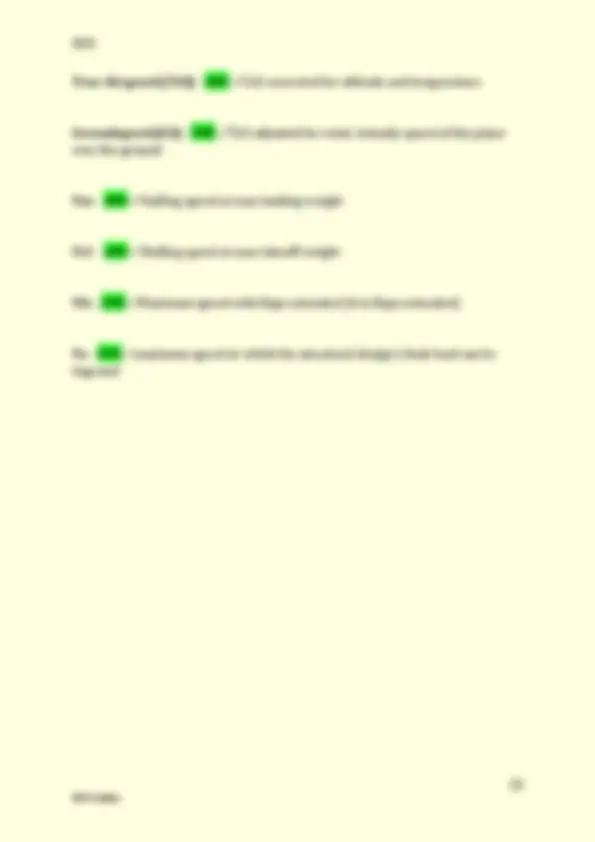


Study with the several resources on Docsity

Earn points by helping other students or get them with a premium plan


Prepare for your exams
Study with the several resources on Docsity

Earn points to download
Earn points by helping other students or get them with a premium plan
Community
Ask the community for help and clear up your study doubts
Discover the best universities in your country according to Docsity users
Free resources
Download our free guides on studying techniques, anxiety management strategies, and thesis advice from Docsity tutors
Vlo - ANS ✓Maximum speed you can extend the landing gear at remember it by lo = landing operating (in motion) Vle - ANS ✓maximum speed you can fly with landing gear extended remember it by le = landing extended Vx - ANS ✓airspeed that gains most altitude in SHORTEST DISTANCE Vy - ANS ✓airspeed that gains most altitude in SHORTEST TIME Is Vx or Vy better for clearing an obstacle? - ANS ✓Vx Vyse (blue line) - ANS ✓If ur in a multi engine plane and one engine takes an L, this is the best rate of climb speed with one engine operating
Typology: Exams
1 / 23

This page cannot be seen from the preview
Don't miss anything!
















Vlo - ANS ✓Maximum speed you can extend the landing gear at remember it by lo = landing operating (in motion) Vle - ANS ✓maximum speed you can fly with landing gear extended remember it by le = landing extended Vx - ANS ✓airspeed that gains most altitude in SHORTEST DISTANCE Vy - ANS ✓airspeed that gains most altitude in SHORTEST TIME Is Vx or Vy better for clearing an obstacle? - ANS ✓Vx Vyse (blue line) - ANS ✓If ur in a multi engine plane and one engine takes an L, this is the best rate of climb speed with one engine operating Vmc - ANS ✓minimum speed you can control a multiengine plane if one engine takes an L What does EFD stand for and what is mother name for it - ANS ✓Electronic Flight Display. Other name is glass cockpit
Trend Vector - ANS ✓Its the little magenta line on EFDs that shows what speed or altitude the plane will be in 6 seconds What is the pressure required for instrument operations? - ANS ✓between 4.5 "Hg and 5.5 "Hg Inclinometer - ANS ✓Displays aircraft yaw If the turn coordinator ball is off to the right, which rudder pedal do you step on? - ANS ✓"step on the ball". If the ball is to the right step on the right pedal and vice versa Magnetic Compass - Variation - ANS ✓Magnetic north isn't the same location as geographic north. Variation is the difference between these two norths Magnetic Compass - Deviation - ANS ✓Error in the compass caused by aircraft parts or current, etc If true course is 180* + 10* variation - 2* deviation from correction card = what compass course? - ANS ✓188* (180 + 10 - 2) What does the pitot tube do? - ANS ✓Measures dynamic pressure which controls the ASI, VSI, and other instruments What is the standard barometric pressure at standard temperature at sea level? - ANS ✓29.92 "Hg What is considered standard temperature - ANS ✓15C or 59F
Three types of Parasite drag? - ANS ✓Form - generated by aircraft shape Interference - caused by intersection of airstreams (i.e. wing to fuselage) Skin Friction - friction caused by materials. This is why composites are good because they reduce skin friction Two types of drag? - ANS ✓Parasite - it in no way helps flight. Caused by aircraft structure Induced - Caused by lift Wake Turbulence - ANS ✓Disturbed air caused by aircraft. To avoid, either rotate before preceding aircraft, separate paths by 1000ft, touch down before preceding aircraft Lateral stability? - ANS ✓This is roll stability. Can create stability by dihedral wings. remember it by LateROLL Directional Stability - ANS ✓Stability about the vertical axis (yaw) Propellor Blade design - ANS ✓propellors are twisted so that the inside produce more pull then the outside cause the outside needs less because it moves faster Adverse Yaw - ANS ✓Plane tends to move left because right side of propellor creates more thrust, corkscrewing of the slipstream, and other stuff that I'm too lazy to write down Load limit - ANS ✓Amount of G's a plane can handle. Normal planes range from 3.8 to - 1.
What's a chandelle - ANS ✓Maneuver where you climb and turn at the same time Rate of Turn - ANS ✓To find degrees per second, it's: (1091 x tan(bank angle)) / speed So for a 30* turn at 120 knots, it'd be 1091 x tan(30) / 120 = 1091 x .577 / 120 = 5.25 degrees / sec Radius of Turn - ANS ✓R = v^2 / (11.26 x tan(bank angle)) ex. 120 knots and 30* 120^2 / 11.26 x tan(30) = 14,400 / 11.26 x .0577 = 2215 FEET CG - ANS ✓Aircraft stalls at a higher speed with forward CG Aircraft becomes less stable as CG moved rearward Mach number - ANS ✓Ratio of true airspeed to speed of sound in the same atmospheric conditions Speed of sound decreases as you increase alt, so mach .82 at FL310 is 306KCAS but at FL380, mach .82 is 261KCAS This is important for limit load --> Coffin's corner
Standard Fuel for GA - ANS ✓standard fuel is 100LL. weight is 6lb / gallon What turns on the electrical system? - ANS ✓Master Switch A Certificate of Aircraft Registration - ANS ✓Must be kept in plane at all times. Proof the aircraft is registered with the FAA Airworthiness Certificate - ANS ✓A certificate issued by the FAA to all aircraft that have been proven to meet the minimum standards set down by the Code of Federal Regulations. AOC - ANS ✓Angle of Climb. Max AOC at full thrust is worse than ROC at full thrust L/Dmax - ANS ✓The maximum ratio between total lift (L) and total drag (D) This point provides the best glide speed Any deviation from the best glide speed increases drag and reduces the distance you can glide Vno - ANS ✓Maximum structural cruising speed Vne - ANS ✓Never exceed speed Landing - ANS ✓ 60 - 70 percent of deceleration on landing is done by aerodynamics so once u get to 30 - 40% of landing speed, use brakes (but always check POH)
Gross weight increases landing distance and landing speed - ANS ✓good luck we will get a perfect score on this test! Troposphere - ANS ✓First layer of atmosphere that planes fly in. 20, 000 - 60,000 ft. Every 1000 ft, temp drops about 2*C Force of rotation of Earth called Coriolis Effect - ANS ✓This effect creates circulation of wind High pressure areas - ANS ✓usually dry, descending air. Associated with good weather. opposite for low pressure turbulence - ANS ✓Convective currents can occur anywhere there is an uneven heating of the Earth's surface Air coming off of a mountain becomes ultra turbulent Wind shear - ANS ✓a sudden, drastic change in wind speed and/or direction over a very small area. Microburst - ANS ✓the most intense type of downburst Wind Symbols - ANS ✓Isobars lines that show wind (closer together means stronger winds) The key things that show wind strength. two circles is calm half line is 5 knots full line is 10 triangle is 50
Front - ANS ✓The boundary where unlike air masses meet but do not mix 4 types - cold, warm, stationary, occluded Warm Front - ANS ✓Warm overtakes cold. Slow moving. Can create thunderstorms. Fog develops. Hazy / low visibility north and east. mainly affects visibility Symbol is red line with red semi circles facing towards movement Cold Front - ANS ✓Faster. Stays low. Lots of rain. faster = more rain and thunderstorms. low visibility. associated with bad weather. moves south and east Blue line with blue triangles facing movement Stationary Front - ANS ✓warm and cold equal power. Creates weather for a couple days that doesn't really move. Blue and red line occluded front - ANS ✓cold sweeps in under warm. creates lots of bad weather purple line Thunderstorm - ANS ✓three stages - growing, mature, and dissipating. can't fly over them in GA aircraft because they are too tall. Start out as cumulus clouds
FSS (Flight Service Station) - ANS ✓Primary source preflight weather info. You can get it by calling 1- 800 - WX BRIEF HIWAS (Hazardous Inflight Weather Advisory Service - ANS ✓Gives weather warnings over selected VOR navigation aids. On a map, its symbol is "H" Steps of a weather briefing - ANS ✓Adverse Conditions VFR Flight not recommended? Synopsis Current Conditions En Route Forecast Destination Forecast Winds and Temp NOTAMS ATC Delays Other info METAR - ANS ✓Gives weather info for specific airport ex. METAR KCDC 020927Z AUTO 14021G26KT 3/4SM R17L/1400Ft +TSRA BR BKN008 OVC012CB 18/17 A2970 RMK PRESFR KCDC = cedar city airport 02 0927Z =2nd day of the month, 0927Z = 9:27 Zulu time AUTO = came from automated source 14021 = 140* is the direction - 21 is the wind speed G26KT = Gusts reach 26kts 3/4SM = visibility is .75 statute miles R17L/1400FT = Runway 17 Left has visibility of 1400ft
ATIS (Automatic Terminal Information Service) - ANS ✓Briefs about weather. ATIS Bravo is more updated than ATIS Alpha and ATIS Charlie is more updated than ATIS Bravo, etc also gives info about instrument approaches and runways in use Holding lines and ILS - ANS ✓Like a stop sign. May be yellow lines on black or white letters on red sign. For yellow lines on black, the dashed lines are towards the runway. Stop before double solid. Think of it like solid lines is a solid choice. cross when atc clears you. If they tell you to hold short of ILS critical area, u must stop before Land Short - ANS ✓If clear to land use entire runway but if ATC says land short of intersecting runway 23, you must stop before that runway. Must let them know if u can or cannot do it depending on ur plane and weight Lighting - ANS ✓Runway Centerline lighting system (RCLS) in the middle - changes from white to red shows where the center is Omnidirectional - blue that outline taxiways Runway Guard Lights - Flashing yellow. Act as holding line VHF - ANS ✓Very High Frequency. Most common radio type Light Gun Signals - ANS ✓Steady green = clear for land, takeoff Flashing green = clear for taxi steady red = stop / give other aircraft priority flashing red = don't land flashing white= only for ground return to origin at airport
alternating green and red - EXTREME CAUTION Class A Airspace - ANS ✓18,000 ft MSL up to and including FL600. Within 12 NM of coast overlying waters. IFR conditions. Must have two-way radio communication systems Mainly for airlines Class B Airspace - ANS ✓Surface up to 10,000 ft MSL surrounding nation's busiest airports; upside-down wedding cake. ATC clearance required / cannot fly in it without permission, also must have two-way radio communication systems and ADB-S equipment minimum VFR is 3 SM and stay clear of clouds can't exceed 250kts solid blue line on chart Class C Airspace - ANS ✓Surface to 4,000 ft above airport elevation within 5 NM radius. also upside down wedding cake for two layers need act contact but don't need clearance VFR 3SM and stay 500ft below clouds, 1000ft above clouds and 2000 ft from can't exceed 200kts purple solid line on chart Class D Airspace - ANS ✓Tower controlled that aren't specified as class B or C need to establish connection with ATC but no need for clearance cannot exceed 200kts on chart it is a blue dashed line when tower not active, it transforms into class E Class E Airspace - ANS ✓Not A, B, C, or D. Everything else. Most of the US is class E
VFR Terminal Area Charts (TAC) - ANS ✓For flying near class B airspace. more detailed 1 in = 4SM Mainly typography World Aeronautical Chart (WAC) - ANS ✓Less detailed 1 in = 16 SM Similar to sectional charts Latitude and longitude - ANS ✓latitudinal lines (parallels) are parallel to the equator longitudinal lines (meridians) are perpendicular to the equator. Prime Meridian goes through Greenwich, England and is the base for measurements. Pacific Standard Time and Mountain Standard time to UTC (Universal Coordinated Time) - ANS ✓PST add 8 hours MST add 7 hours CST add 6 hours EST add 5 hours True North = geographic north - ANS ✓good luck on the test To fly a heading of x degrees TN, what must you fly magnetically - ANS ✓x +- variation* Variation east = - Variation west = + ex. Fly 60* with variation 7W = 60 + 7 = 67*
Fly 60* with variation 5E = 60 - 5 = 65* (plus account for deviation see what it is on a deviation card) Intended path, course, WCA - ANS ✓Intended path = where u wanna go Course = where u go WCA wind correction angle) is applied to align course with intended path HOW TO CONVERT FROM KNOTS TO MPH - ANS ✓MULTIPLY KNOT SPEED BY
I REPEAT, CONVERSION FACTOR IS 1. MPH ALWAYS GREATER THAN KNOTS BECAUSE MORE FEET PER NAUTICAL MILE 250 NM trip. 100knots /hour. 5 gallons/hour. How much fuel used? - ANS ✓250Nm / 50 knots = 5 hours. 5 gallons per hour = 5x5 = 25 gallons Pilotage vs Dead Reckoning - ANS ✓pilotage is flying based off of landmarks dead reckoning is flying headings predetermined. Sectional Chart Airport Symbols - ANS ✓if an airport has a blue circle around it, it means is from 1500 to 8069 in length. It also means it has ATC If an airport has a purple circle around it, it is the same as a blue circle, but it means it has NO ATC If it doesn't have a circle around it, it's length is greater than 8069ft. color rules still apply. Circle around the Letter R means it's a private airport
triangle with "UC" means under construction (MEF) Maximum Elevation Figure - ANS ✓On a sectional chart, gives max height of obstruction such as a mountain looks like this: 10^8 =MEF of 10800ft or 2^4 = MEF of 2400ft Airspace on Sectional Charts - ANS ✓Class B given with a Blue fraction numerator = ceiling denominator = floor ie. (imagine this in blue writing) 90/16 = 9000ft ceiling. 1600ft floor Class C = same thing but with purple writing Class D = Surrounded by blue dashed lines VOR's - ANS ✓VOR is a hexagon VOR/DME = hexagon in square (dme is distance measuring equipment) shows distance from VOR VOR TACAN = hexagon with three black squares on it (tacan = TACtical Air Navigation) VOR's are aligned to Magnetic North
CDI (Course Deviation Indicator) - ANS ✓shows if ur on track with a VOR. (How to fly on a VOR Radial) If the needle is in the center u r good. If its to the left, you must turn to the left if the needle is to the right u must turn to the right to get it on center OBS (Omni Bearing Selector) - ANS ✓you turn it to point to where u want to go and the CDI Needle will help u from there How to determine which radial u r on from a VOR - ANS ✓Dial in VOR frequency (get on a sectional chart) Turn OBS until the needle is centered and it says 'from' if the question was to a VOR you'd turn it to 'to' Also it doesn't matter what ur heading is because u can still be on a radial Then check your DME and thats how far away u r from a VOR How to fly to, ex. KCDC VOR. - ANS ✓Dial in VOR frequency turn OBS to 'to' turn until needle centered lets say it's 190, then u turn your plane to 190 but remember to account for variation and deviation and wind every airspace is controlled except for G - ANS ✓the only uncontrolled airspace is G max airspeed below 10000 and in class B airspace is - ANS ✓250KTS 1/100 of an inch of mercury is 9.7ft - ANS ✓Therefore, the difference between 29.92 and 29.94 is 19.4ft (9.7x2)